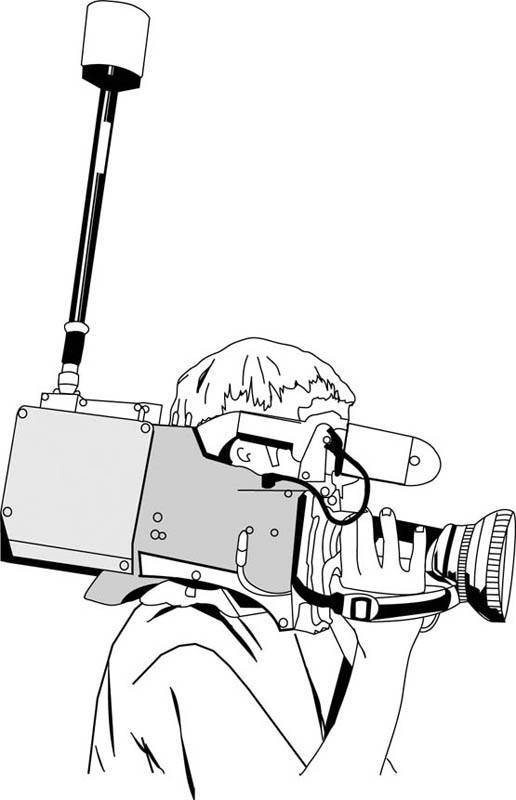Radio cameras
There are occasions when it is not feasible to physically connect the camera to the microwave or SNG truck, and therefore another means has to be used. Cable-free cameras or radio cameras provide complete freedom of movement for the camera operator to obtain interesting shots or to follow fast action.
Examples when this might occur are:
• where the cameraman is going to be moving around a good deal to different shooting positions
• where the physical distance between the camera and the truck is further than is feasible to connect with a cable
• when running a cable means crossing an area that has a lot of people (particularly crowds) walking across it
• where the camera is going to be used on a moving vehicle, such as at a horse race where the camera is going to run alongside the track keeping pace with the runners and riders.
The solution to this scenario is to use a compact low-power short-range microwave link between the camera and the truck, which carries both the video signal and the accompanying audio. This type of camera set-up is commonly called a ‘radio-cam’. The link mounts on the rear of the camera, and is powered from the camera battery. Radio-cams have been used for years in sports, news and OBs. Unfortunately, with analogue transmission the pictures often break up, as the problem is that the signal bounces off walls, vehicles, trees and people, which distorts the received signal.
The biggest problem in using such a link is maintaining a clear path between the antenna on the back of the camera and the receiving antenna on the truck, and failure to achieve this leads to problems. Therefore the options are:
• separately mount the antenna on a pole, carried by an assistant, who keeps the antenna pointing towards the receive antenna
• use an omnidirectional antenna
• use an auto-tracking antenna.
The disadvantage of the first option is obvious – it requires another person, and the pointing of an antenna on the pole could very well be difficult in a crowded situation. It is viable if the cameraman is going to stay in one position, or within a fairly closely defined area.
The second option is commonly used on low cost radio-cam links, and for many situations is perfectly acceptable, though this needs careful co-ordination between the camera operator and the assistant. Commonly, problems are encountered when the signal is blocked or fading, causing picture and/or audio break-up.
Radio-cam

The third option is the most flexible but also the most expensive. The auto-tracking system is actually a two-way system, where a control signal is transmitted back from the receiver to the camera-mounted antenna to steer the transmit antenna so that it can direct the camera-mounted antenna towards the receiver. Again, the signal fed back is derived from the AGC measured at the receiver. As an example of this type of system, we will look at the TRACS system developed in the United Kingdom.
Analogue radio-cam links
Analogue radio-cam links have been around since the 1980s, but they have always suffered from problems relating to path difficulties – fading, dropouts, etc. Because of their poor reputation for reliability, they were never widely used, and when they were, they had to be set up days in advance and checked thoroughly – suitable for an OB, but not for a breaking news event.
In the 1990s, the BBC developed and licensed for manufacture a switched-antenna microwave camera link which provides a two-way video and audio link, which broadcast video and audio between the camera-mounted microwave unit (called C-TRACS) and a tracking microwave antenna system unit (called B-TRACS) at the truck. A return or reverse video feed can be sent from the base station to the camera viewfinder, as well as two-way talkback channel. The return video feed enables the cameraman to see what is actually being transmitted from the truck. The TRACS system was very effective, but due to its high cost is typically only used during major events such as premier soccer matches, where the cameraman is running up and down the touchline.
Digital radio-cam links
The problems with the simpler systems and the cost of the sophisticated systems like TRACS hindered the wider acceptance of radio-cams.
However, recently digital camera-mounted links using MPEG-2 digital compression have been developed, offering much better performance. Remembering that the signal transmitted by a COFDM needs to be digitally compressed, these systems offer exceptional signal robustness with minimal delay – and delay is the key here. We will look at this in more detail when we look at compression, but inevitably when a signal is digitally compressed, the signal is delayed as it goes through the encoding process. In addition, there is some delay in the COFDM process itself.
The significance of this in particular with a radio-cam is as follows. Imagine that a football match is being covered. A camera up in the stand area covers the winning goal. The director in the OB production truck then instantly cuts to the digital COFDM radio-cam on the touchline, and the picture from the digital radio-cam shows the ball going into the back of the net again – because the video is delayed due to the processing in compression and COFDM transmission. The original prototype of this type of camera had approximately 18 frames (3/4s) of delay – which is a very large delay. The current production prototype has reduced this delay to 3 frames – which is just about acceptable. Hopefully this delay will be reduced to the optimum, which would be 2 frames or less.
Several manufacturers have developed compact digital links that fit onto the back of ENG camcorders, and some include bidirectional connectivity to give some remote control to the camera.
Camcorder mounted radio link (© Link Research)

